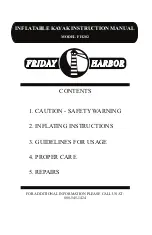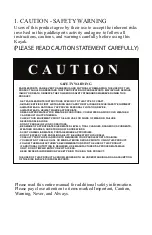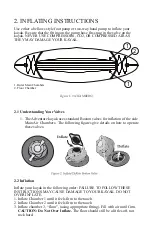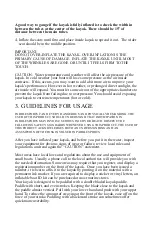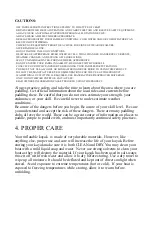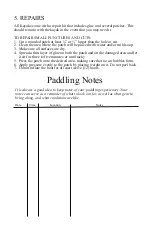
3. GUIDELINES FOR USAGE
PADDLESPORTS CAN BE VERY DANGEROUS AND PHYSICALLY DEMANDING. THE
USER OF THIS PRODUCT SHOULD UNDERSTAND THAT PARTICIPATION IN
PADDLESPORTS MAY INVOLVE SERIOUS INJURY OR DEATH. OBSERVE THE
FOLLOWING SAFETY STANDARDS WHENEVER USING THIS PRODUCT. THE USER OF
THIS PRODUCT ACKNOWLEDGES BOTH AN UNDERSTANDING AND AN
ASSUMPTION OF THE RISK INVOLVED IN PADDLESPORTS.
After you have inflated your kayak, and before you put it in the water, inspect
your equipment for obvious signs of wear or failure, review local rules and
regulations, and read again the “CAUTION” statement.
Most areas have local laws and regulations about the use and equipment of
small boats. Usually a phone call to the local authorities will provide you with
the needed information. Some areas may require that you register, and display a
registration number on the front of the kayak. Once you have been issued a
number, it is best to affix it to the kayak by printing it on the material with a
permanent ink marker. If you are required to display a sticker or vinyl letters, an
inflatable boat ID kit can be purchased at most marine stores.
Your kayak is designed to be paddled with a double bladed kayak paddle.
Paddle with short, and even strokes. Keeping the blade close to the kayak and
the paddle almost vertical. Pull with your lower hand and push with your upper
hand. To reduce the amount of swaying at the front of the kayak, ease off on the
force of your stroke. Paddling with a backward stroke can sometimes offer
quick maneuverability.
A good way to gauge if the kayak is fully inflated is to check the width in
between the tubes at the center of the kayak. There should be 15” of
distance between the main tubes.
4. Inflate the seats until firm and place inside kayak to spread it out. The wider
seat should be in the middle position.
IMPORTANT:
DO NOT OVER-INFLATE THE KAYAK. OVER-INFLATION IS THE
PRIMARY CAUSE OF DAMAGE. INFLATE THE KAYAK UNTIL MOST
OF THE WRINKLES ARE GONE OR UNTIL IT FEELS FIRM TO THE
TOUCH.
CAUTION: Water temperature and weather will affect the air pressure of the
kayak. In cold weather your boat will lose some pressure as the air inside
contracts. If this occurs, you may want to add a bit more air to improve your
kayak's performance. However in hot weather, or prolonged direct sunlight, the
air inside will expand. You must let some air out of the appropriate chambers to
prevent the kayak from failing due to overpressure. You should avoid exposing
your kayak to extreme temperatures (hot or cold).
Содержание FH202
Страница 8: ...SIERRA STERLING toll free 888 545 1424 ...


